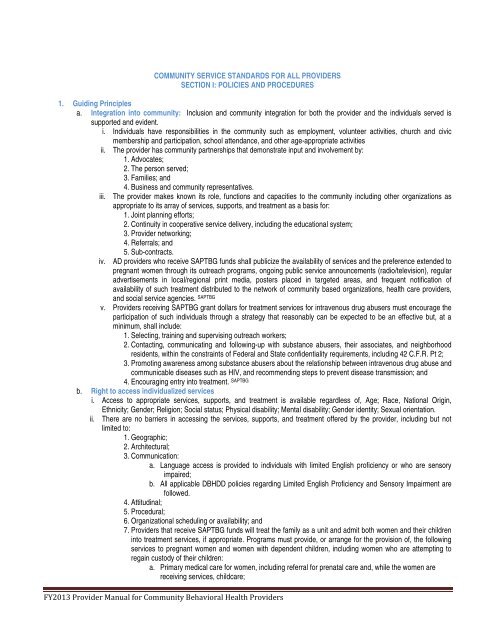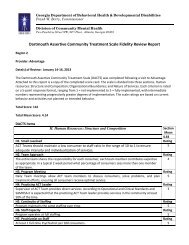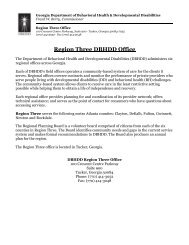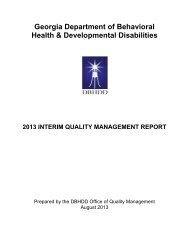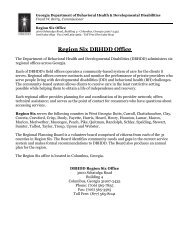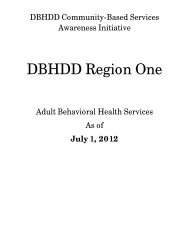PART I - Department of Behavioral Health and Developmental ...
PART I - Department of Behavioral Health and Developmental ...
PART I - Department of Behavioral Health and Developmental ...
Create successful ePaper yourself
Turn your PDF publications into a flip-book with our unique Google optimized e-Paper software.
COMMUNITY SERVICE STANDARDS FOR ALL PROVIDERSSECTION I: POLICIES AND PROCEDURES1. Guiding Principlesa. Integration into community: Inclusion <strong>and</strong> community integration for both the provider <strong>and</strong> the individuals served issupported <strong>and</strong> evident.i. Individuals have responsibilities in the community such as employment, volunteer activities, church <strong>and</strong> civicmembership <strong>and</strong> participation, school attendance, <strong>and</strong> other age-appropriate activitiesii. The provider has community partnerships that demonstrate input <strong>and</strong> involvement by:1. Advocates;2. The person served;3. Families; <strong>and</strong>4. Business <strong>and</strong> community representatives.iii. The provider makes known its role, functions <strong>and</strong> capacities to the community including other organizations asappropriate to its array <strong>of</strong> services, supports, <strong>and</strong> treatment as a basis for:1. Joint planning efforts;2. Continuity in cooperative service delivery, including the educational system;3. Provider networking;4. Referrals; <strong>and</strong>5. Sub-contracts.iv. AD providers who receive SAPTBG funds shall publicize the availability <strong>of</strong> services <strong>and</strong> the preference extended topregnant women through its outreach programs, ongoing public service announcements (radio/television), regularadvertisements in local/regional print media, posters placed in targeted areas, <strong>and</strong> frequent notification <strong>of</strong>availability <strong>of</strong> such treatment distributed to the network <strong>of</strong> community based organizations, health care providers,<strong>and</strong> social service agencies. SAPTBGv. Providers receiving SAPTBG grant dollars for treatment services for intravenous drug abusers must encourage theparticipation <strong>of</strong> such individuals through a strategy that reasonably can be expected to be an effective but, at aminimum, shall include:1. Selecting, training <strong>and</strong> supervising outreach workers;2. Contacting, communicating <strong>and</strong> following-up with substance abusers, their associates, <strong>and</strong> neighborhoodresidents, within the constraints <strong>of</strong> Federal <strong>and</strong> State confidentiality requirements, including 42 C.F.R. Pt 2;3. Promoting awareness among substance abusers about the relationship between intravenous drug abuse <strong>and</strong>communicable diseases such as HIV, <strong>and</strong> recommending steps to prevent disease transmission; <strong>and</strong>4. Encouraging entry into treatment. SAPTBGb. Right to access individualized servicesi. Access to appropriate services, supports, <strong>and</strong> treatment is available regardless <strong>of</strong>, Age; Race, National Origin,Ethnicity; Gender; Religion; Social status; Physical disability; Mental disability; Gender identity; Sexual orientation.ii. There are no barriers in accessing the services, supports, <strong>and</strong> treatment <strong>of</strong>fered by the provider, including but notlimited to:1. Geographic;2. Architectural;3. Communication:a. Language access is provided to individuals with limited English pr<strong>of</strong>iciency or who are sensoryimpaired;b. All applicable DBHDD policies regarding Limited English Pr<strong>of</strong>iciency <strong>and</strong> Sensory Impairment arefollowed.4. Attitudinal;5. Procedural;6. Organizational scheduling or availability; <strong>and</strong>7. Providers that receive SAPTBG funds will treat the family as a unit <strong>and</strong> admit both women <strong>and</strong> their childreninto treatment services, if appropriate. Programs must provide, or arrange for the provision <strong>of</strong>, the followingservices to pregnant women <strong>and</strong> women with dependent children, including women who are attempting toregain custody <strong>of</strong> their children:a. Primary medical care for women, including referral for prenatal care <strong>and</strong>, while the women arereceiving services, childcare;FY2013 Provider Manual for Community <strong>Behavioral</strong> <strong>Health</strong> Providers


